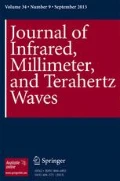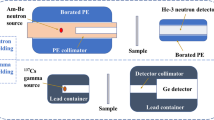Abstract:
Boron carbide (B4C) is one of advanced materials and is being used in a wide rage of applications. The unique feature of this material is its large neutron-absorbing cross-section. Some of its most prominent applications are controlling rods in nuclear reactors and radiation protection. 24 GHz microwave processing for B4C ceramics were performed under flowing argon gas using the sintering system. Sintering at the high temperature (up to 2200°C) was achieved using thermal insulation system consists of fiber-board, boron nitride powder, and boron nitride case. The sintered samples were achieved 90 % of theoretical.
Similar content being viewed by others
References
[1] W. H. Sutton, “Microwave Processing of Ceramic Materials”, Am. Ceram. Soc. Bull., 68 (2), 376–386 (1989).
[2] Yu. V. Bykov, K. I. Rybakov and V. E. Semenov, “High-temperature microwave processing of materials”, Phys. D. Appl. Phys., 34, R55–R77 (2001).
[3] T. T. Meek, C. E. Holcombe and N. Dykes, “Microwave sintering of some oxide materials using sintering aids”, J. Mater. Sci. Lett., 6, 1060–1062 (1987).
[4] M. A. Janney and H. D. Kimrey, “Microwave sintering of Alumina at 28 GHz”, Ceram. Trans., Ceram. Powder. Sci., 919–924 (1988).
[5] C. E. Holcombe, N. L. Dykes, “‘Urutra’ High-temperature microwave sintering”, Am. Ceram. Soc., 21, 375–386 (1991a).
[6] C. E. Holcombe, “New Microwave coupler material”, Am. Ceram. Soc. Bull., 62 (12), 1388 (1983).
[7] S. L. Dole, S. Prichazka and R. H. Doremus, “Microstructural coarsening during sintering of boron carbide”, J. Am. Ceramic. Soc., 72, 958–966 (1989).
[8] K. A. Schwetz, W. Grellner, “The Influence of carbon on the microstructure and mechanical properties of sintered Boron Carbide”, J. Less-Common Metals., 82, 37–47 (1981).
[9] M. A Janny and H. D. Kimery, “Diffusion-controlled processes in microwave-fired oxide ceramics”, Mater. Res. Soc. Proc., 189, 215–227 (1991).
[10] M. Gliavin, Yu. Bykov, G. Denisov et al, “Development of a compact gyrotron system for microwave processing of materials”, J. Jpn. Soc. Infrared Sciand. Tech., 12, 60–64 (2002).
[11] T. Idehara, S. Sabchevski et al, “Microwave sintering of boron carbide” Proceedings of the 7-th International Conference on Electron Beam Technologies, 113–119 (2003).
Author information
Authors and Affiliations
Rights and permissions
About this article
Cite this article
Hoshizuki, H., Mitsudo, S., Saji, T. et al. High Temperature Thermal Insulation System for Millimeter Wave Sintering of B4C. Int J Infrared Milli Waves 26, 1531–1541 (2005). https://doi.org/10.1007/s10762-005-0030-z
Received:
Published:
Issue Date:
DOI: https://doi.org/10.1007/s10762-005-0030-z




